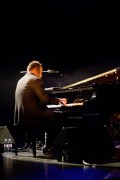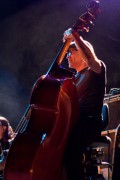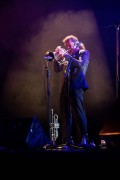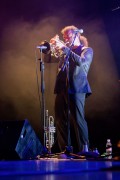Born in Urbino, Raphael Gualazzi has grown up in a sumptuous area, which says a lot about him.“It’s a place drenched with history, a UNESCO Word Heritage site and homeland of many great creators as the painter Raphael. It’s a remote place but very inspiring. Even though I’m living in London now, I love to come back here” says the musician. This is where he started learning the piano at the age of nine. He entered the Music School of Pesaro five years later, and played the piano-forte (derivative of the harpsichord). He studied the classical composers for eight years. In 1995, Raphael Gualazzi discovered jazz thanks to a friend of his father (himself a drummer in a pop band) and a whole new world opened to his ears. He dived into ragtime and 1900’s stride, and started exploring the music of Scott Joplin, Jelly Roll Morton, Fats Waller, Art Tatum and Mary Lou Williams. A bit later, he discovered Duke Ellington, Django Reinhardt and Ray Charles. Even tough he used to sing in a choir, Raphael Gualazzi then decided to focus on playing keyboards. “I love old jazz, he says. It was popular and people danced to it. By today’s standards, it’s become a bit intellectual, but through my feelings, I’m drawn to this more communicative form of expression.”
At the beginning of the new century, Raphael Gualazzi appeared in many festivals. In 2005, he recorded his first album, “Love Outside The Window”, and featured alongside Jamie Callum and Diane Krall on the compilation “Piano Jazz” (for which he recorded “Georgia On My Mind”), two year later. Following this, Raphael Gualazzi was invited to come to Vermont and New Hampshire and be a part of the project “The History & Mystery Of Jazz” with American jazzmen Michael Ray and Steve Ferraris. In 2009, he signed with Sugar Music (through Caterina Caselli). He then played at the Blue Note in Milan and started to write new material. He finally gained worldwide exposure when Gilles Peterson remixed the track “Reality And Fantasy”. The album (named after the song) followed quickly and Raphael Gualazzi has been exposed to a massive audience since then. People have discovered his way of making music, without computers but with real melodies played by real people.
“HAPPY MISTAKE”
“Happy Mistake” won’t surprise whoever discovered the transalpine musician over the least few years. These news songs are like a follow-up to the ones that created a buzz when “Reality And Fantasy” was released (the album sold more than 100 000 copies worldwide). Raphael Gualazzi’s natural inclination for eclectics and melody can be found in these immediate and catchy tunes.
But this time, everything is even more perfect. Fuelled by tours and concerts, Raphael Gualazzi’s songwriting is more refined. As opposed to a musical environment that lacks substance, the young artist in his early thirties seems to write catchy tunes, infused with his piano playing and his slightly raspy voice, without any effort. Those who remember the golden age of Italian vocal pop will unmistakably think of Lucio Dalla, Paolo Conte and Adriano Celentano. Except that Raphael Gualazzi, a tradition lover, is also very much of his time.
If “Happy Mistake” impresses with its immediacy, it’s because it’s been conceived mostly on the spot. While rehearsing or soundchecking, the musician often toys with a few notes before writing them on paper, later.












No comments